Southeast Idaho Phosphate Mining Resource Area - Agency for ...
Southeast Idaho Phosphate Mining Resource Area - Agency for ...
Southeast Idaho Phosphate Mining Resource Area - Agency for ...
Create successful ePaper yourself
Turn your PDF publications into a flip-book with our unique Google optimized e-Paper software.
occur primarily on public lands where a residential scenario cannot occur. Also, it should<br />
be noted that no gardens, residential or otherwise, have been observed on any areas along<br />
streams in the <strong>Resource</strong> <strong>Area</strong> (TtEMI 2002).<br />
Public health implications<br />
Among the above discussed contaminants of concern in the soil, arsenic is the<br />
contaminant of concern with the highest cancer risk. The average concentration of arsenic<br />
in the soil of the impacted area is about 19 times higher than its cancer risk evaluation<br />
guide (CREG) (Appendix C, Table C-1). The CREG is the estimated concentration that<br />
would be expected to cause no more than one additional excess cancer in one million<br />
people exposed over a lifetime (365 days/year × 70 years). As discussed be<strong>for</strong>e, no<br />
residences have been observed along any streams in the <strong>Resource</strong> <strong>Area</strong>. Even <strong>for</strong> people<br />
living in the <strong>Resource</strong> <strong>Area</strong> 190 days per year <strong>for</strong> 70 years, the estimated highest cancer<br />
risk is still below one estimated cancer <strong>for</strong> 100,000 persons exposed. There<strong>for</strong>e, the<br />
contaminants in the soil are highly unlikely to result in any appreciable increase in cancer<br />
risk to hunters, anglers, or collectors in the <strong>Resource</strong> <strong>Area</strong> and residents around the<br />
<strong>Resource</strong> <strong>Area</strong>.<br />
For non-cancer health effects, the maximum concentrations of arsenic, cadmium,<br />
chromium and vanadium are higher than the corresponding CVs <strong>for</strong> children (Appendix<br />
C, Table C-1). However, the average concentrations are all below the CVs <strong>for</strong> children.<br />
Even the maximum concentrations of the above contaminants are still several times lower<br />
than the CVs <strong>for</strong> adults (Appendix C, Table C-1). Since there is little possibility of<br />
children consuming the maximum levels of arsenic, cadmium, chromium, or vanadium in<br />
the soil on a daily basis, the contaminants in the soil are unlikely to result in any adverse<br />
non-cancer health effects to residents, including children, hunters, collectors, and anglers.<br />
Both children and adults are more likely to be exposed to contaminants by ingesting soil<br />
than by inhaling soil (Hawley 1985). However, <strong>for</strong> chemicals that have specific toxic<br />
effects on the respiratory tract (such as chromium and beryllium), special consideration<br />
must be given. EPA Region 9’s residential soil preliminary remediation goals (RS-PRGs)<br />
take into account the ingestion, inhalation, and dermal absorption of contaminants in soil.<br />
While the maximum concentration of chromium is higher than its RS-PRG (210<br />
miligrams per kilogram, mg/kg, 1:6 ratio Cr VI: Cr III), the average concentration is<br />
below the RS-PRG. As discussed above, there is little possibility of children consuming<br />
the maximum levels of chromium in the soil on a daily basis due to no one residing in the<br />
mining areas. Also, even the maximum concentration of beryllium in the soil is below its<br />
RS-PRG (150 mg/kg). There<strong>for</strong>e, beryllium and chromium in surface soil are unlikely to<br />
result in any adverse health effects through ingestion, inhalation, and dermal contact.<br />
In conclusion, ingestion of the contaminants, inhalation of the contaminants, and dermal<br />
contact with the contaminants in the soil in the <strong>Resource</strong> <strong>Area</strong> are unlikely to result in<br />
cancer or adverse non-cancer health effects <strong>for</strong> hunters, anglers, collectors, and residents,<br />
including children, who live near or recreate in the <strong>Resource</strong> <strong>Area</strong>.<br />
10
















